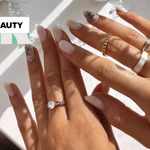Anyone who knows me knows that Vaseline (or petroleum jelly) is my one-and-done cure-all. Cuts, scrapes, dry skin, chapped lips, you name it; as far as I’m concerned, there is nothing Vaseline can’t fix it. Heck, I’d venture to guess it could even fix a squeaky door if need be.
Vaseline is an important part of my skincare. So much so that I keep tubes and jars of this magical emollient strategically placed around my home and in my handbag. So, imagine my surprise when I discovered that Vaseline is an integral part of an entire skincare trend - slugging.
Once I realized that the world would finally see what I see in Vaseline, I had to do a little digging to find out more. Ahead, I share my findings on what slugging really is. Spoiler alert, the news is every bit as good as I thought it would be.
What Is Slugging?
Making its way into the beauty world courtesy of K-Beauty and skyrocketing to popularity courtesy of Reddit, slugging is essentially taking petrolatum, which most of us know as Vaseline, and slathering it onto your face before bed. If all goes as it should, you’ll wake up with skin that’s renewed and deeply moisturized.
Now some people may snub the idea of layering petroleum jelly all over their skin, but it’s important to know while it feels “different,” maybe even thick and heavy, it’s not bad for your skin and, in most cases, it won’t cause breakouts. Yes, Vaseline is occlusive. Yes, it feels completely wrong (especially for those who were taught that oily skin is just bad), but the truth is slugging can be invaluable, particularly for those who have chronic dry skin.
Essentially, the science behind slugging is that you apply a layer of some type of heavy-duty occlusive (most people use Vaseline, petroleum jelly, or even a rich night cream) to prevent trans-epidermal water loss. When given the time to work its magic, slugging keeps your skin hydrated and it does the heavy lifting to restore your skin’s moisture barrier.
Who Should Try Slugging?
Slugging is typically best for those with extremely dry skin. After all, the whole idea is to seal in hydration and prevent water loss, which is what causes dry skin in the first place, right?
Of course, people with oily skin may be a bit hesitant to add more oil to their skin, and that’s completely understandable. Truth be told, if you have naturally oily skin or even acne-prone skin, you probably don’t need that kind of deep, intense hydration in the first place. Moreover, even if you’re using non-comedogenic products, slugging creates an occlusive environment that tends to trap dead skin and oil, and that can lead to, you guessed it, more breakouts.
The bottom line - if you have oily acne-prone skin, you may want to skip this one. If your skin is always dry and tight, this might be the thing that finally works.
How To Try Slugging
What surprised me the most is that slugging is really just an additional step to your normal skincare routine. You don’t forego your serums and moisturizers; instead, you lather on your chosen occlusive over those layers to seal the moisture in. Here’s a rundown of the process.
Step 1: Start With A Blank Canvas And Clean Skin
Remember that slugging creates a seal on your skin, and while it’s great for sealing in moisture, you don’t want to inadvertently trap dirt makeup and other debris that’s lingering there. So before you attempt to try slugging, make sure that your face is completely clean.
Step 2: Carry On With Your Regular Skin Care And Moisturizing Routine
To reiterate, the occlusive does not impart moisture to your skin; your serums and moisturizers do that. The occlusive only prevents moisture from seeping out. So, after you’ve cleaned your skin, follow your normal skincare routine and apply your serums and moisturizers.
Step 3: Apply Your Occlusive
For the final step in the process, you get to the slugging portion of the program. This is where you take your chosen occlusive and press it onto your skin. Remember that you’re not rubbing it in, but instead, you’re leaving a generous layer of it on your skin. Also, remember to let it set for a few minutes, so it doesn't go directly onto your pillowcase.
Which Products Should You Use For Slugging?
Typically most people choose Vaseline for their initial foray into slugging. It’s cheap, it’s effective, and it’s likely something that most people have on hand. And to be honest, Vaseline is kind of perfect - but again, I may be biased. If you’re not sold on slathering Vaseline on your face, you could try a rich, thick cream that’s non-comedogenic. Nivea cream is a good option. Beyond that, you could opt for products that are rich in ceramides or jojoba oil, for example, as they can also give your slugging a moisturizing boost.







